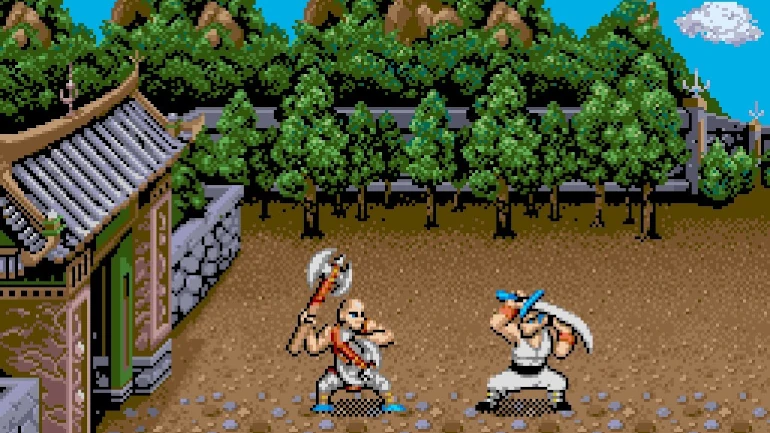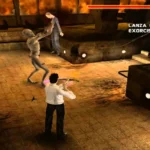Tiger Road – The Sleeper Hit of Arcade Beat 'em Ups!

For many who see PlayStation as the beginning of consoles, it's hard to imagine how many games classic companies made in their early years in the market. Sometimes, you also get that typical know-it-all saying something like, "Capcom started with Final Fight," to which you reply… "Are you stupid?" Then you show them some of their earlier marvels, and the guy just drops dead. Continuing the Made in Paco series (starting with Dragon Ninja…), I’m once again drawing inspiration from their arcade classics, this time with a very well-known cabinet: Tiger Road.
Though I almost went with Bionic Commando, in the end, I had to pay tribute to the Chinese guy with the kilometer-long jumps who spent his life taking out evil monks to rescue some poor kids. The game wasn’t fully developed by Capcom but by a lesser-known company called Romstar in 1987, later being ported to home computers like the Amstrad CPC.
The story puts us in the shoes of Lee Wong, a young martial arts apprentice trying to master the powers of the tiger while training at his village temple. Everything’s going fine until one day, the game’s charismatic villain kidnaps some temple children and takes them to his castle. The fate of those young kids rests in Wong’s hands, and we’ll have to rescue them by fighting through a variety of stages. We have to admit, early Capcom wasn’t too imaginative with their plots—almost all of them were the same. Then again, when you think about it… they’re still doing the same thing today.
But never mind that. Setting aside the adventures of the Chinese Lee, let’s focus on the gameplay and what it meant for one of Capcom’s most brilliant platformers.
Gameplay
This is a traditional platformer where we advance through the screen until we find an exit. Along with the usual forward-scrolling areas, there are also some vertical flying sections. In my opinion, Tiger Road was one of Capcom’s hardest games of its time. The first stage was manageable (though the boss was tough), but the ones after? Brutal. Right after starting, we take control of Wong, a character with basic moves (jump, walk, attack) who could sometimes fly thanks to a special mat given by his master.
In the first stage, our hero is armed with a nice axe, but later we can swap it for other weapons found in chests, like a mace or a spear. Like any self-respecting platformer, this addictive game is full of items—some give points, while colored bottles either increase (or decrease) the character’s health. While the main goal is to advance far enough to exit the screen, we’ll often need to use ladders, sub-levels, or traps to keep moving forward.
As for enemies, they were pretty scary. On one hand, we have the weaklings that die in one hit, then some Hulk Hogan-style giants that take more punishment, and finally, the stage bosses. Honestly, if I could get back all the money I spent on continues thanks to those brutal bosses, I’d probably be chilling on a nice boat right now with two cute girls fanning me.
Maybe the most fun part of the game was how fast everything moved. Enemies never stopped spawning, and they’d chase you relentlessly until you killed them or they took one of your lives. After long hours grinding the machine, my friends and I developed different strategies—wait for this enemy here, corner that one, stuff like that.
Sure, other games like Ghosts 'n Goblins had similar mechanics, but Tiger Road was borderline genius in both gameplay and overall design. Who could resist dropping a few coins into the cabinet? (And it was cheap, too.) Nobody! Especially if we rigged it to select levels—though actually beating the game? That’s a whole different story.
Graphics
Following the style of other Capcom classics, the adventures of our little Chinese Wong offer highly detailed stages filled with Oriental landscapes full of little details that any fan would appreciate. The four major areas where the game takes place include caves full of snakes, haunted houses, temples, and a forest packed with angry Chinese guys.
As for our hero, he’s very much a product of his time—simple animations with little realism, a ridiculously long jump, and, of course, the classic monk’s bald head. The rest of the characters, whether enemies or otherwise, follow typical movement patterns—move-attack, jump-attack—making them easy to handle after the second encounter.
Music & Sound
What would Tiger Road be without its music and sound effects? Absolutely nothing. A second after starting, we already hear the swoosh swoosh of our attacks, followed by the little noises enemies make when they die. In the background, we have the soundtrack—Oriental-style tunes that get overshadowed by the game’s amazing sound effects.
Conclusion
It’s a real shame Capcom doesn’t seem to own the rights to Tiger Road anymore. Where could they be now? It’d be awesome to see our little bald Chinese guy in the next Capcom vs. Marvel or something similar. For now, we’ll have to settle for fun articles like this one. And remember—if you still think Capcom started with Final Fight, try giving Tiger Road (or any of their older games) a spin. Next time, I’ll talk about my beloved Bionic Commando, that little soldier who swung around stages while bosses just stood there stunned.





Leave a Reply